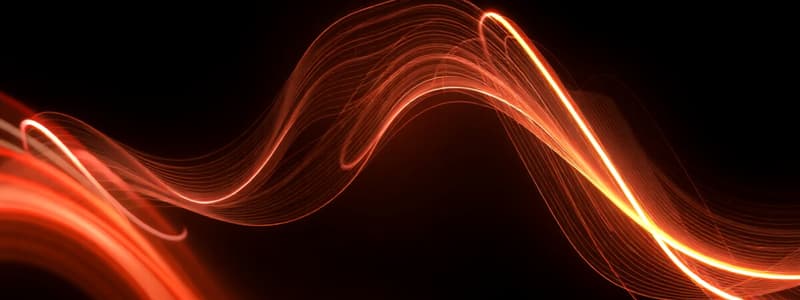Podcast
Questions and Answers
What is the primary source of natural light on Earth?
What is the primary source of natural light on Earth?
- The sun (correct)
- Artificial bulbs
- Fire
- The moon
Which of the following describes how light travels?
Which of the following describes how light travels?
- In straight lines and at a constant speed (correct)
- In zigzag patterns and only in darkness
- In circles and at light speed only
- In curved paths and at varying speeds
What phenomenon occurs when light passes through a prism?
What phenomenon occurs when light passes through a prism?
- Refraction (correct)
- Diffraction
- Reflection
- Absorption
What is the term for the range of different colors produced when light is split?
What is the term for the range of different colors produced when light is split?
Which statement best describes the behavior of light in relation to obstacles?
Which statement best describes the behavior of light in relation to obstacles?
Flashcards
What is light?
What is light?
Light is a form of electromagnetic radiation that allows us to see.
How does light travel?
How does light travel?
Light travels in straight lines, creating shadows when objects block its path.
How fast is light?
How fast is light?
The speed of light is incredibly fast, about 299,792,458 meters per second.
What is visible light?
What is visible light?
Signup and view all the flashcards
What are the wavelengths of light?
What are the wavelengths of light?
Signup and view all the flashcards
Study Notes
Electromagnetic Spectrum
- Light is a form of electromagnetic radiation.
- The electromagnetic spectrum encompasses all types of electromagnetic radiation, from radio waves to gamma rays.
- Visible light occupies a small portion of this spectrum.
- Light travels in waves, characterized by wavelength and frequency.
- Wavelength is the distance between two consecutive peaks or troughs of a wave.
- Frequency is the number of waves that pass a given point per unit of time.
- Wavelength and frequency are inversely proportional.
- The speed of light in a vacuum is approximately 299,792,458 meters per second.
Speed of Light
- The speed of light in a vacuum is a fundamental constant in physics.
- It is denoted by the letter 'c'.
- The speed of light in other mediums is slower than in a vacuum.
- The refractive index of a medium describes how much slower light travels in that medium compared to a vacuum.
- The refractive index is always greater than or equal to 1.
Properties of Light
- Light exhibits both wave-like and particle-like behavior (wave-particle duality).
- Light can be described as a collection of discrete energy packets called photons.
- The energy of a photon is proportional to its frequency (higher frequency = higher energy).
- This is often summarized in the equation E=hf, where E is energy, h is Planck's constant, and f is frequency.
- Light can be reflected, refracted, diffracted, and scattered.
- Reflection is the bouncing of light off a surface.
- Refraction is the bending of light as it passes from one medium to another.
- Diffraction is the spreading of light as it passes through an aperture or around an obstacle.
- Scattering involves light being absorbed and re-emitted in different directions.
Color and Light
- Different colors of light correspond to different wavelengths within the visible spectrum.
- Red light has the longest wavelength, and violet light has the shortest wavelength.
- The visible spectrum ranges from approximately 400 to 700 nanometers.
- Combining different colors of light can produce different colors.
- Mixing certain wavelengths of light can create white light, demonstrating additive color mixing.
Light Sources
- Light sources can be natural (e.g., the sun, stars) or artificial (e.g., light bulbs, lasers).
- Incandescent light bulbs produce light by heating a filament until it glows.
- Fluorescent lamps use ultraviolet radiation to excite phosphor coatings, producing visible light.
- LEDs (Light Emitting Diodes) produce light via electroluminescence.
- Lasers produce highly focused, coherent light waves.
Applications of Light
- Light is crucial for vision and photography.
- Light is used in optical communication and data transmission.
- Light is used in various scientific instruments (e.g., microscopes, telescopes).
- Light is used medical applications such as laser surgery and optical coherence tomography.
- Light is used in sensors, particularly light-detecting and -measuring devices that find applications in various industries.
- Light is an essential part of many industrial processes, including printing, manufacturing, and quality control.
Light and the Human Eye
- The human eye detects light through specialized photoreceptor cells.
- Rods are responsible for vision in low light conditions.
- Cones are responsible for color vision.
- The lens in the eye focuses light onto the retina.
- The parts of the eye respond to stimulus from light allowing sight/vision.
Studying That Suits You
Use AI to generate personalized quizzes and flashcards to suit your learning preferences.




